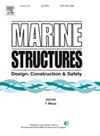Experimental investigation on thermal response of stiffened panel under high-temperature gas leakage
IF 5.1
2区 工程技术
Q1 ENGINEERING, CIVIL
引用次数: 0
Abstract
High-temperature gas is widely used in ship power systems. As service time increases, pipeline damage will lead to high-temperature gas leakage which will cause structural expansion. The surrounding constraint will prevent the expansion resulting in thermal stress threatening the safety of the hull structure. There is limited research focusing on the impact of high-temperature gas leakage on the thermal response of structures. It is a complex fluid-structure coupling problem that should consider the gas diffusion, structural heat absorption and expansion to simulate the realistic gas leakage scenario. In this paper, to investigate the thermal response of stiffened panel under the action of high-temperature gas, a set of experimental equipment including a steam generation module, a stiffened panel and a signal acquisition module is designed. The effects of high temperature, leakage distance and leakage pressure on the thermal response of panel are investigated. The results show that the high-temperature gas will significantly amplify the stress response of the panel. The center of the panel which is directly opposite to the leakage hole shows an obvious impact effect. The leakage pressure affects the temperature distribution little and mainly influences the stress and displacement. The leakage distance has an effect on the temperature, stress and deformation distribution simultaneously. With the increase of the leakage distance, the extreme temperature, stress and displacement will reduce. The results can deepen the understanding of the mechanism of high-temperature gas leakage on structural thermal response and provide certain guidance to the numerical simulation and hull structural design.
高温气体泄漏下加筋板热响应试验研究
高温气体在船舶动力系统中有着广泛的应用。随着使用时间的延长,管道损坏将导致高温气体泄漏,引起结构膨胀。周围的约束可以防止膨胀产生的热应力威胁船体结构的安全。高温气体泄漏对结构热响应的影响研究有限。它是一个复杂的流固耦合问题,需要考虑气体扩散、结构吸热和膨胀等因素来模拟真实的气体泄漏情况。为了研究加筋板在高温气体作用下的热响应,设计了一套包括蒸汽发生模块、加筋板和信号采集模块在内的实验设备。研究了高温、泄漏距离和泄漏压力对面板热响应的影响。结果表明,高温气体会显著放大面板的应力响应。与漏孔正对面的面板中心有明显的冲击效果。泄漏压力对温度分布影响较小,主要影响应力和位移。泄漏距离对温度、应力和变形分布均有影响。随着泄漏距离的增加,极端温度、应力和位移会减小。研究结果可以加深对高温气体泄漏对结构热响应机理的认识,为数值模拟和船体结构设计提供一定的指导。
本文章由计算机程序翻译,如有差异,请以英文原文为准。
求助全文
约1分钟内获得全文
求助全文
来源期刊

Marine Structures
工程技术-工程:海洋
CiteScore
8.70
自引率
7.70%
发文量
157
审稿时长
6.4 months
期刊介绍:
This journal aims to provide a medium for presentation and discussion of the latest developments in research, design, fabrication and in-service experience relating to marine structures, i.e., all structures of steel, concrete, light alloy or composite construction having an interface with the sea, including ships, fixed and mobile offshore platforms, submarine and submersibles, pipelines, subsea systems for shallow and deep ocean operations and coastal structures such as piers.
 求助内容:
求助内容: 应助结果提醒方式:
应助结果提醒方式:


